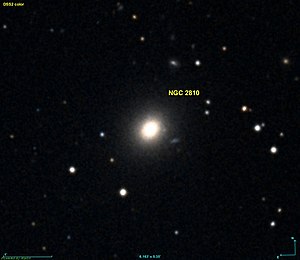NGC 2810
| Galaxy NGC 2810 |
|
|---|---|

|
|
| AladinLite | |
| Constellation | Big Bear |
|
Position equinox : J2000.0 , epoch : J2000.0 |
|
| Right ascension | 09 h 22 m 04.5 s |
| declination | + 71 ° 50 ′ 38 ″ |
| Appearance | |
| Morphological type | E. |
| Brightness (visual) | 12.2 mag |
| Brightness (B-band) | 13.2 mag |
| Angular expansion | 1.7 ′ × 1.7 ′ |
| Surface brightness | 13.4 mag / arcmin² |
| Physical data | |
| Redshift | 0.011915 ± 0.000025 |
| Radial velocity | 3572 ± 7 km / s |
|
Stroke distance v rad / H 0 |
(165 ± 11) · 10 6 ly (50.5 ± 3.5) Mpc |
| history | |
| discovery | William Herschel |
| Discovery date | December 3, 1788 |
| Catalog names | |
| NGC 2810 • UGC 4954 • PGC 26514 • CGCG 332-045 • MCG + 12-09-042 • IRAS F09173 + 7203 • 2MASX J09220451 + 7150383 • GC 1795 • H III 749 • NVSS J092204 + 715038 | |
NGC 2810 is an elliptical galaxy of Hubble type E0 in the constellation Ursa Major on the northern sky . It is estimated to be 165 million light years from the Milky Way and about 80,000 light years in diameter.
The object was discovered on December 3, 1788 by the astronomer Wilhelm Herschel .
